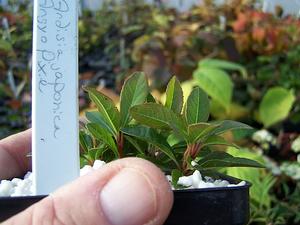View All Plants :: View All BROADLEAF EVERGREEN SHRUBS :: View All SHRUBS
Ardisia japonica 'Angyo Pixie'
Marlberry
Plant Type:
BROADLEAF EVERGREEN SHRUBSArdisia japonica 'Angyo Pixie' - A very dwarf selection of Marlberry. 'Angyo Pixie' is essentially the species with glossy green leaves, pink-white flowers followed by gorgeous, persistent red berries but on a ground covering plant of much smaller stature than its larger brother. Starry pink to white spring flowers give way to very gorgeous glossy red berries looking like miniature apples which persist into the following spring. Dark green glossy leaves looking as if they were made of vinyl display serrated, almost spiny looking edges. This is the smallest form of Marlberry which will eventually make a lush, suckering ground cover in fertile, moisture retaining acid soil in part sun to open shade. The specie hails from eastern China, Japan and Korea; where the refined 'Angyo Pixie' was found - whether in the wild or in the garden we do not know. Established potted Marlberry from division.
Characteristics and Attributes for Ardisia japonica 'Angyo Pixie'
Season of Interest (Flowering)
- Late Spring / Early Summer
Season of Interest (Foliage)
- Four Seasons
Autumn Interest
- Fruit / Berries / Seed Heads
Light
- Dappled Shade
- Morning Sun / Afternoon Shade
- Shade
Attributes
- Small / Miniature
- Natural Garden
- Border
- Bank
- Edging
- Fruiting
- Evergreen
- Ground Cover
Growth Rate in the Garden
- Moderately Fast
Soil
- Organic
- Woodland
- Fertile
- Humus Laden
- Draining
Origins
- China, Japan, Korea
Propagated By
- Cutting Grown
Genus Overview: Ardisia
Family: Primulaceae · Common Name: Coralberry, Marlberry
Ardisia japonica, known commonly as Coralberry and Marlberry, is a shrubby, ground covering member of Primulaceae. Numerous species exist from the New World, the Pacific Islands, Australia, Asia with a vast number of species occurring in the tropics. We grow a number of fine selections from the species, A. japonica. These grow from 10 to 16(+) inches tall. Leaves are usually whorled or at least in an opposite template. Late spring flowers are pale pink to white, though small they are quite pretty and are held in racemes. The fruit that follows transforms from green to brilliant red and is persistent. "Berries" can approach the size of a dime and sometimes a little large. They are rounded and look like miniature apples. Ardisia, in its 2,500 year history of Chinese folk medicine, considers Ardisia japonica as one of the 50 fundamental herbs. We generally grow it for its phenomenal ornamental character. They are resplendent as they ground cover in shady, dappled or early morning or late day sun. Late morning to latish afternoon filtered light is important. Fertile, moisture retaining ground is a requirement. The many selections provide delight in their ground covering capacity. Not as well appreciated in U.S. gardens these plants are worthy where they can be grown outdoors. But potted plants allow for close up appreciation for their many merits - 4 season interest for sure - farther north if a cool window, porch, greenhouse or conservatory are part of your domain. USDA climate zones 7 to 9(10).


